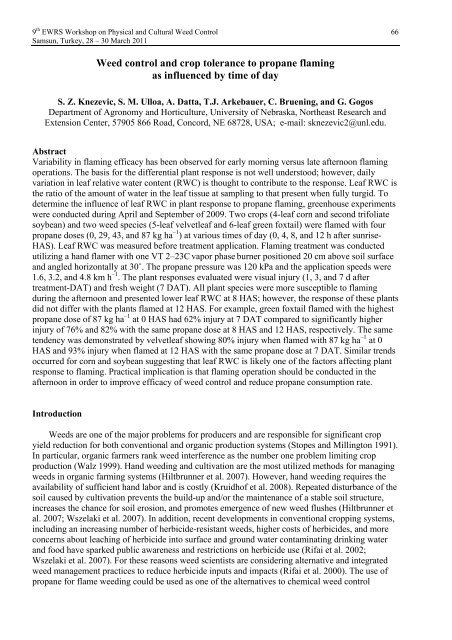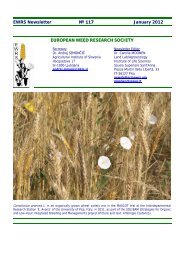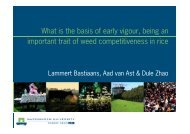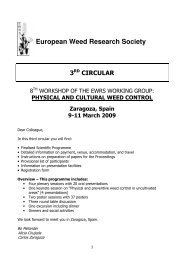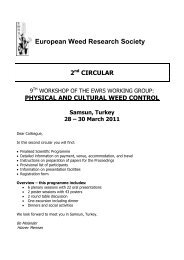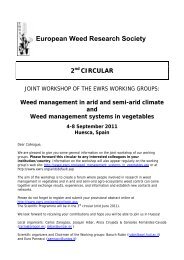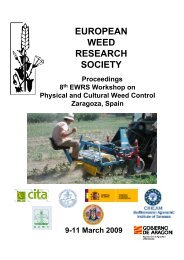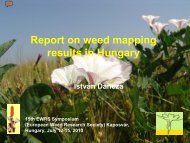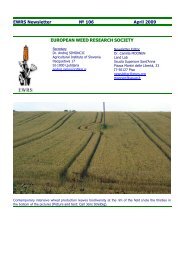Physical and Cultural Weed Control Working Group of - European ...
Physical and Cultural Weed Control Working Group of - European ...
Physical and Cultural Weed Control Working Group of - European ...
You also want an ePaper? Increase the reach of your titles
YUMPU automatically turns print PDFs into web optimized ePapers that Google loves.
9 th EWRS Workshop on <strong>Physical</strong> <strong>and</strong> <strong>Cultural</strong> <strong>Weed</strong> <strong>Control</strong> 66<br />
Samsun, Turkey, 28 – 30 March 2011<br />
<strong>Weed</strong> control <strong>and</strong> crop tolerance to propane flaming<br />
as influenced by time <strong>of</strong> day<br />
S. Z. Knezevic, S. M. Ulloa, A. Datta, T.J. Arkebauer, C. Bruening, <strong>and</strong> G. Gogos<br />
Department <strong>of</strong> Agronomy <strong>and</strong> Horticulture, University <strong>of</strong> Nebraska, Northeast Research <strong>and</strong><br />
Extension Center, 57905 866 Road, Concord, NE 68728, USA; e-mail: sknezevic2@unl.edu.<br />
Abstract<br />
Variability in flaming efficacy has been observed for early morning versus late afternoon flaming<br />
operations. The basis for the differential plant response is not well understood; however, daily<br />
variation in leaf relative water content (RWC) is thought to contribute to the response. Leaf RWC is<br />
the ratio <strong>of</strong> the amount <strong>of</strong> water in the leaf tissue at sampling to that present when fully turgid. To<br />
determine the influence <strong>of</strong> leaf RWC in plant response to propane flaming, greenhouse experiments<br />
were conducted during April <strong>and</strong> September <strong>of</strong> 2009. Two crops (4-leaf corn <strong>and</strong> second trifoliate<br />
soybean) <strong>and</strong> two weed species (5-leaf velvetleaf <strong>and</strong> 6-leaf green foxtail) were flamed with four<br />
propane doses (0, 29, 43, <strong>and</strong> 87 kg ha –1 ) at various times <strong>of</strong> day (0, 4, 8, <strong>and</strong> 12 h after sunrise-<br />
HAS). Leaf RWC was measured before treatment application. Flaming treatment was conducted<br />
utilizing a h<strong>and</strong> flamer with one VT 2–23C vapor phase burner positioned 20 cm above soil surface<br />
<strong>and</strong> angled horizontally at 30˚. The propane pressure was 120 kPa <strong>and</strong> the application speeds were<br />
1.6, 3.2, <strong>and</strong> 4.8 km h –1 . The plant responses evaluated were visual injury (1, 3, <strong>and</strong> 7 d after<br />
treatment-DAT) <strong>and</strong> fresh weight (7 DAT). All plant species were more susceptible to flaming<br />
during the afternoon <strong>and</strong> presented lower leaf RWC at 8 HAS; however, the response <strong>of</strong> these plants<br />
did not differ with the plants flamed at 12 HAS. For example, green foxtail flamed with the highest<br />
propane dose <strong>of</strong> 87 kg ha –1 at 0 HAS had 62% injury at 7 DAT compared to significantly higher<br />
injury <strong>of</strong> 76% <strong>and</strong> 82% with the same propane dose at 8 HAS <strong>and</strong> 12 HAS, respectively. The same<br />
tendency was demonstrated by velvetleaf showing 80% injury when flamed with 87 kg ha –1 at 0<br />
HAS <strong>and</strong> 93% injury when flamed at 12 HAS with the same propane dose at 7 DAT. Similar trends<br />
occurred for corn <strong>and</strong> soybean suggesting that leaf RWC is likely one <strong>of</strong> the factors affecting plant<br />
response to flaming. Practical implication is that flaming operation should be conducted in the<br />
afternoon in order to improve efficacy <strong>of</strong> weed control <strong>and</strong> reduce propane consumption rate.<br />
Introduction<br />
<strong>Weed</strong>s are one <strong>of</strong> the major problems for producers <strong>and</strong> are responsible for significant crop<br />
yield reduction for both conventional <strong>and</strong> organic production systems (Stopes <strong>and</strong> Millington 1991).<br />
In particular, organic farmers rank weed interference as the number one problem limiting crop<br />
production (Walz 1999). H<strong>and</strong> weeding <strong>and</strong> cultivation are the most utilized methods for managing<br />
weeds in organic farming systems (Hiltbrunner et al. 2007). However, h<strong>and</strong> weeding requires the<br />
availability <strong>of</strong> sufficient h<strong>and</strong> labor <strong>and</strong> is costly (Kruidh<strong>of</strong> et al. 2008). Repeated disturbance <strong>of</strong> the<br />
soil caused by cultivation prevents the build-up <strong>and</strong>/or the maintenance <strong>of</strong> a stable soil structure,<br />
increases the chance for soil erosion, <strong>and</strong> promotes emergence <strong>of</strong> new weed flushes (Hiltbrunner et<br />
al. 2007; Wszelaki et al. 2007). In addition, recent developments in conventional cropping systems,<br />
including an increasing number <strong>of</strong> herbicide-resistant weeds, higher costs <strong>of</strong> herbicides, <strong>and</strong> more<br />
concerns about leaching <strong>of</strong> herbicide into surface <strong>and</strong> ground water contaminating drinking water<br />
<strong>and</strong> food have sparked public awareness <strong>and</strong> restrictions on herbicide use (Rifai et al. 2002;<br />
Wszelaki et al. 2007). For these reasons weed scientists are considering alternative <strong>and</strong> integrated<br />
weed management practices to reduce herbicide inputs <strong>and</strong> impacts (Rifai et al. 2000). The use <strong>of</strong><br />
propane for flame weeding could be used as one <strong>of</strong> the alternatives to chemical weed control


